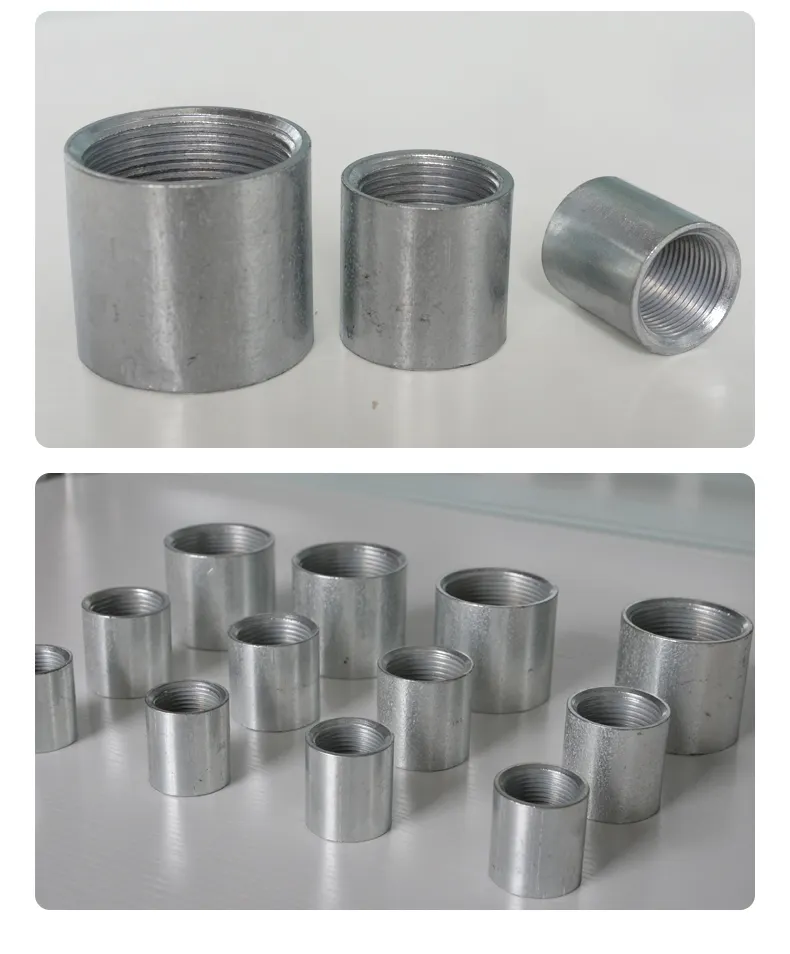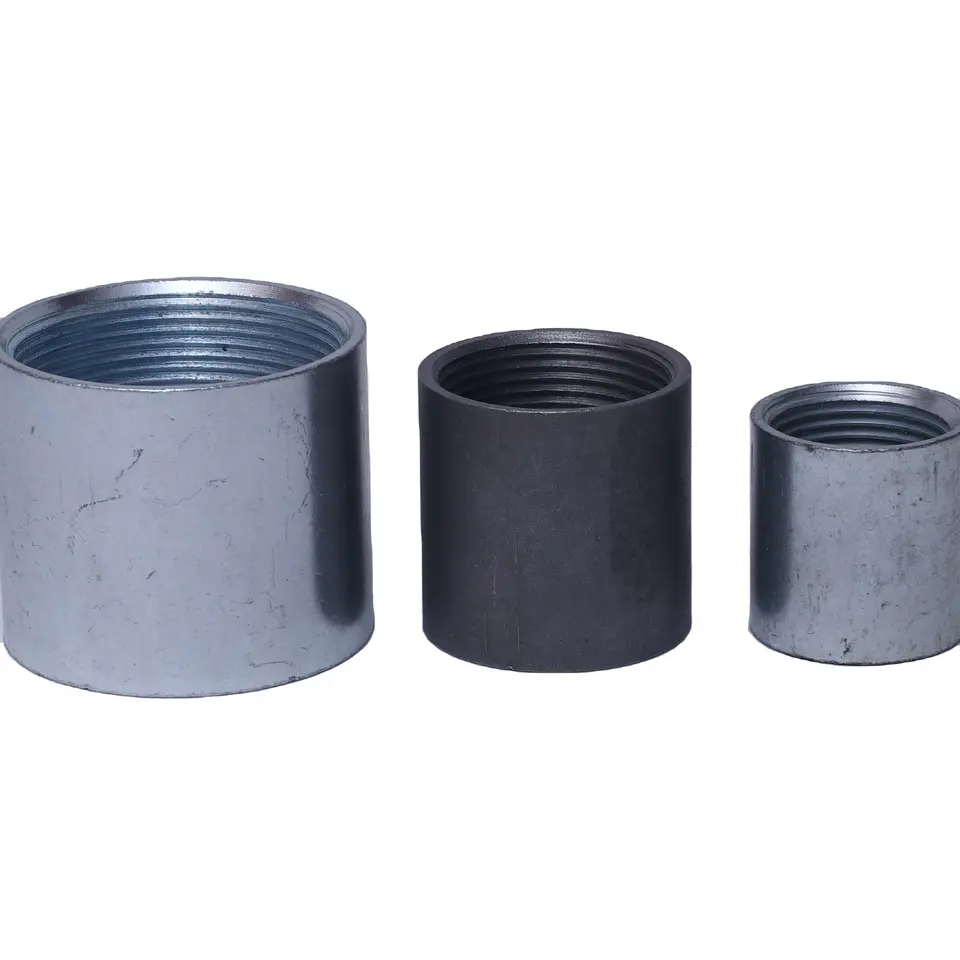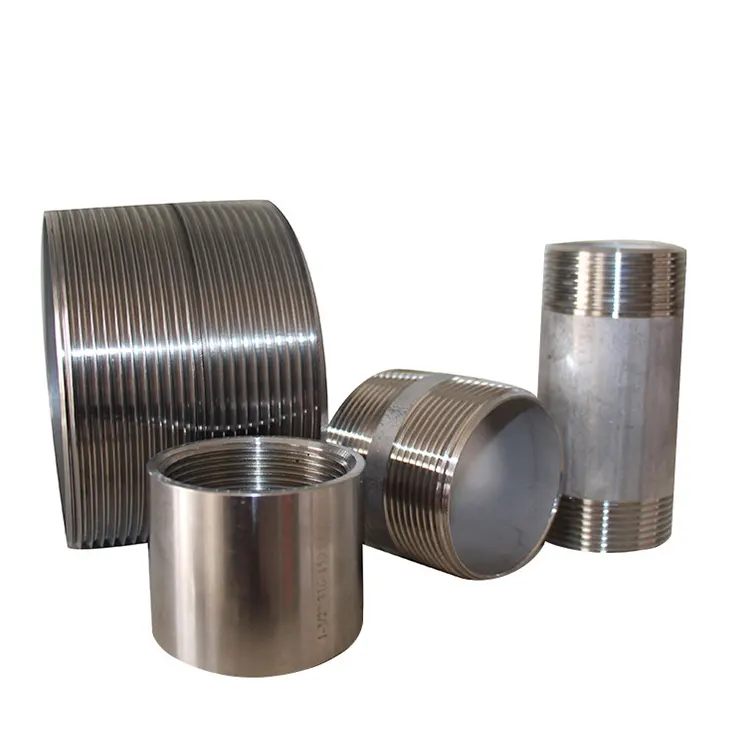Product Description
Socket Weld Class 3000 A105n Half Coupling
Product Parameters
|
Product Name |
Pipe coupling |
|
Size |
1/8″-4″ |
|
Standard |
ANSI B16.11 |
|
Pressure |
2000lbs, 3000lbs,6000lbs, 9000lbs |
|
Type |
full coupling or half coupling |
| End | Threaded or socket welded |
|
Process |
Forged |
|
Surface |
CNC machined, anti-rust oil, HDG(hot dip galv.) |
|
Material |
Carbon steel: A105, A350 LF2,etc. |
|
Pipeline steel: ASTM 694 f42, f52, f60, f65,f70 and etc. |
|
| Stainless steel: A182F304/304L, A182 F316/316L, A182F321, A182F310S, A182F347H, A182F316Ti, 317/317L, 904L, 1.4301, 1.4307, 1.4401, 1.4571, 1.4541, 254Mo and etc. | |
| Duplex stainless steel: ASTM A182 F51, F53,F55, UNS31803, SAF2205, UNS32205, UNS32750 , UNS32760, 1.4462,1.4410,1.4501 and etc. | |
| Nickel alloy: inconel600, inconel625, inconel690, incoloy800, incoloy 825, incoloy 800H,C22, C-276, Monel400, Alloy20 etc. | |
|
Cr-Mo alloy steel: A182 f11,f22,f5,f9,f91, 10CrMo9-10, 16Mo3 etc. |
|
|
Application |
Petrochemical industry;aviation and aerospace industry;pharmaceutical industry,gas exhaust; power plant;ship building; water treatment, etc. |
|
Advantages |
ready stock,faster delivery time;available in all sizes,customized;high quality |
Detailed Photos
End can be socket weld or thread
Marking
Various marking can be curved, or painting by laser on your request. We accept to mark your LOGO
Inspection
1. Dimension measurements, all within standard tolerance.
2. Accept Third party inspection
3. Supply MTC, EN15714 3.1/3.2 certificate
Packaging & Shipping
1. Packed by carton first, then Packed by plywood case as per ISPM15
2. we will put packing list on each package
3. we will put shipping markings on each package. Markings words are on your request.
4. All wood package materials are fumigation free
Our Advantages
Why Choose us
7*24 service time
trace shippment each week
Professional QC QA team, more than 5 people. Inspect all goods before delivery
REFUND MONEY IF REJECTION BECAUSE OF QUALITY
PAYMENT TERM CAN BE L/C at sight, L/C 30/60/90days, O/A 30/60/90days, D/P at sigth, 30/45/60 days
OUR FACTORY SHOW
CZIT GROUP(3 factories, 300+workers, 200 +customers, 20+ years experience)
5000tons production capacity each month, fast delivery.
2000#, 3000#, 2″ and below size, A105 fittings are ready to ship
CERTIFICATE SHOW
CUSTOMER FEEDBACK
What is business for us? Not only for earn money, it is for sharing. To meet more better us together.
For us, customers would like cooperate with us, we are very happy and appreciated. Thank you very much for your trust us. We will do what we promise.
Since we treat business very serious, customers would like establish long term relationship with us. And when they gave us FIVE STAR comments, we really very very moved. We will do our best to do more better.
OUR PROJECTS SHOW
Our products can be used in Petrochemical industry;aviation and aerospace industry;pharmaceutical industry,gas exhaust; power plant;ship building; water treatment, etc.
Here is some projects samples for your reference.
FAQ
| FAQ |
| Q: Can you supply Form e, Certificate of origin? |
| A: Yes, we can supply |
| Q: Can you supply invoice and CO with chamber of commerce? |
| A: Yes, we can supply. |
| Q: Can you accept L/C deferred 30, 60, 90days? |
| A: We can. |
| Q: Can you accept O/A payment? |
| A: We can. |
| Q: Can you supply samples? |
| A: Yes, some samples are free. |
| Q: Can you supply the products which comply with NACE? |
| A: Yes, we can. |
| Q: Can you visit your factory |
| A: Yes, sure. Welcome. |
| Q: Can you inspect the goods before delivery |
| A: Yes, sure. Welcome to our factory inspect the goods. Also accept third party inspection, such as SGS, TUV, BV etc. |
| Q: Can you supply MTC , EN15714 3.1/3.2 certificate? |
| A: Yes, sure. we can |
| Q: Do you have ISO |
| A: Yes, we have |
| Q: Can you accept OEM? |
| A: Yes, we can |
| Q: Can you accept marking our LOGO? |
| A: Yes, we can |
| Q: What is your MOQ? |
| A: 1pcs for standard fittings and flanges. |
| Q: Can you support to design our piping system? |
| A: Yes, we would like to your partner and our engineer will help. |
| Q: Can you offer data sheet and drawing? |
| A: Yes, we can |
| Q: Can you ship by carrier or airline? |
| A: Yes, we can. And we also can ship by train |
| Q: Can you combine your order with other supplier? Then ship together? |
| A: Yes, we can. We would like help you ship together to save your time and money |
| Q: Can you shorten delivery time? |
| A: If very very urgent, please confirm with sales. We would like arrange extra-working time for you. |
| Q: Can you marking on package as per IPPC? |
| A: Yes, we can |
| Q: Can you mark “MADE IN CHINA” on products and packing? |
| A: Yes, we can |
| Q: Can you supply semi-finished products? |
| A: Yes, we can |
| Q: We need some test sample pieces for each heat number, Can you supply? |
| A: Yes, we can |
| Q: Can you supply heat treatment report? |
| A: Yes, we can |
/* January 22, 2571 19:08:37 */!function(){function s(e,r){var a,o={};try{e&&e.split(“,”).forEach(function(e,t){e&&(a=e.match(/(.*?):(.*)$/))&&1
What are the Maintenance Requirements for Half Couplings to Ensure Their Longevity?
Proper maintenance is essential to ensure the longevity and reliable performance of half couplings in piping and plumbing systems. Regular maintenance helps prevent wear, corrosion, and other issues that could lead to leaks or failures. Here are the maintenance requirements for half couplings:
- Inspection: Regularly inspect all half couplings in the system for signs of wear, corrosion, or damage. Check for visible leaks or indications of moisture around the joints. Perform visual inspections and, if necessary, use non-destructive testing methods to assess the integrity of the couplings.
- Cleaning: Keep the half couplings clean and free from dirt, debris, or other contaminants. Clean the coupling surfaces and surrounding areas during maintenance to ensure a proper fit and prevent corrosion.
- Lubrication: For threaded half couplings, apply a suitable lubricant or thread sealant when assembling the connection. This helps prevent galling and ensures a smooth and secure fit between the threads.
- Protection from Corrosion: Take measures to protect the half couplings from corrosion, especially in environments where corrosion is likely. Consider using corrosion-resistant materials for the couplings or applying protective coatings to prevent rusting.
- Temperature and Pressure Considerations: Ensure that the half couplings are suitable for the operating temperature and pressure of the system. High-temperature or high-pressure applications may require special materials or additional maintenance considerations.
- Replacement of Worn or Damaged Couplings: If any half coupling shows signs of wear, damage, or reduced performance during inspections, promptly replace it with a new one. Avoid using couplings that do not meet the necessary standards or show signs of fatigue.
- Proper Installation: During maintenance or replacement, ensure that the half couplings are correctly installed following the manufacturer’s instructions and industry best practices. Proper installation is crucial for achieving a secure and leak-free connection.
- Consider Thermal Expansion: Account for thermal expansion and contraction in the system to prevent stress on the half couplings and other components. Adequate flexibility and expansion joints can help accommodate temperature changes.
- Regular System Checks: Perform regular system checks to monitor the overall health and performance of the piping or plumbing system. Address any issues detected during these checks promptly to prevent cascading problems.
Adhering to these maintenance requirements will help ensure the longevity and reliable operation of the half couplings, contributing to the overall efficiency and safety of the piping or plumbing system.
How do you Calculate the Required Size and Specifications for a Half Coupling?
Calculating the required size and specifications for a half coupling involves considering several factors related to the piping system and the intended application. Here’s a step-by-step guide on how to calculate the size and specifications:
- Identify the Pipe Size: Determine the size of the pipe to which the half coupling will be connected. The pipe size is usually specified in inches and represents the nominal diameter of the pipe.
- Consider the Pipe Material: Know the material of the pipe, such as carbon steel, stainless steel, PVC, copper, or others. The half coupling material should be compatible with the pipe material to avoid any galvanic corrosion or other issues.
- Assess the Operating Pressure: Determine the maximum operating pressure of the system in which the half coupling will be used. The half coupling should have a pressure rating that exceeds the maximum operating pressure to ensure safety and reliability.
- Calculate the Torque Requirements: For threaded half couplings, calculate the required torque for proper thread engagement. The torque calculation involves considering the thread pitch, thread diameter, and the material of the pipe and coupling.
- Check the Temperature Range: Evaluate the temperature range in which the half coupling will be operating. Ensure that the material chosen can withstand the maximum and minimum temperatures of the system without any adverse effects.
- Account for Environmental Factors: Consider any environmental factors that may affect the half coupling’s performance, such as exposure to chemicals, UV radiation, or extreme weather conditions. Select a material and coating, if necessary, to protect the coupling from environmental degradation.
- Verify Compliance with Standards: Ensure that the selected half coupling meets relevant industry standards and specifications, such as ASME, ASTM, API, or ISO, to guarantee its quality and performance.
- Factor in the Application: Consider the specific application of the half coupling, such as its use in a water supply system, chemical process, high-pressure pipeline, or industrial equipment. The application requirements will influence the material selection, pressure rating, and other specifications.
- Consult with Experts: If unsure about the calculations or specifications, consult with piping system experts or engineers who can provide guidance and ensure the proper selection of the half coupling based on the system’s requirements.
By following these steps and carefully considering the pipe size, material, pressure, torque, temperature, environmental conditions, compliance with standards, application, and seeking expert advice when needed, you can accurately calculate the required size and specifications for a half coupling that will perform optimally in the piping system.
Can a Half Coupling be Used to Join Pipes of Different Diameters?
Yes, a half coupling can be used to join pipes of different diameters in piping and plumbing systems. Half couplings are specifically designed to connect two pipes of different sizes, making them ideal for creating transitions or connections between pipes with varying diameters. The larger end of the half coupling is welded or screwed onto the larger diameter pipe, providing a stable base for the connection. The smaller pipe, which has a different diameter, is then threaded or inserted into the smaller end of the half coupling.
The ability to join pipes of different diameters is one of the main advantages of using half couplings. This feature allows for efficient and smooth transitions between pipe sizes, which is crucial in maintaining proper fluid flow, reducing pressure losses, and preventing turbulence within the system.
Here are some common scenarios where half couplings are used to join pipes of different diameters:
- Reducing Pipe Size: When a pipeline needs to change from a larger diameter to a smaller diameter, a half coupling can be employed to create a smooth transition. For example, if a process requires a reduction in flow rate, a smaller pipe can be connected to the main pipeline using a half coupling.
- Connecting Equipment or Valves: In many industrial applications, equipment, valves, or instruments are connected to the main pipeline using half couplings. Often, these components have different pipe sizes than the main pipeline, and a half coupling provides a secure and leak-proof joint.
- Repair and Maintenance: During repair or maintenance operations, a damaged section of the pipeline can be cut out, and a new pipe of a different diameter can be connected using a half coupling. This allows for quick repairs without having to replace the entire pipeline.
When using a half coupling to join pipes of different diameters, it is essential to ensure that the threads and dimensions of the coupling match the pipes being connected. Proper sealing techniques, such as using thread sealant or Teflon tape, should also be applied to prevent leaks and ensure a reliable connection.
In conclusion, half couplings are versatile pipe fittings that enable the joining of pipes with different diameters. Their ability to facilitate smooth transitions and secure connections makes them invaluable in various industrial, commercial, and residential applications.
editor by CX 2024-03-18




